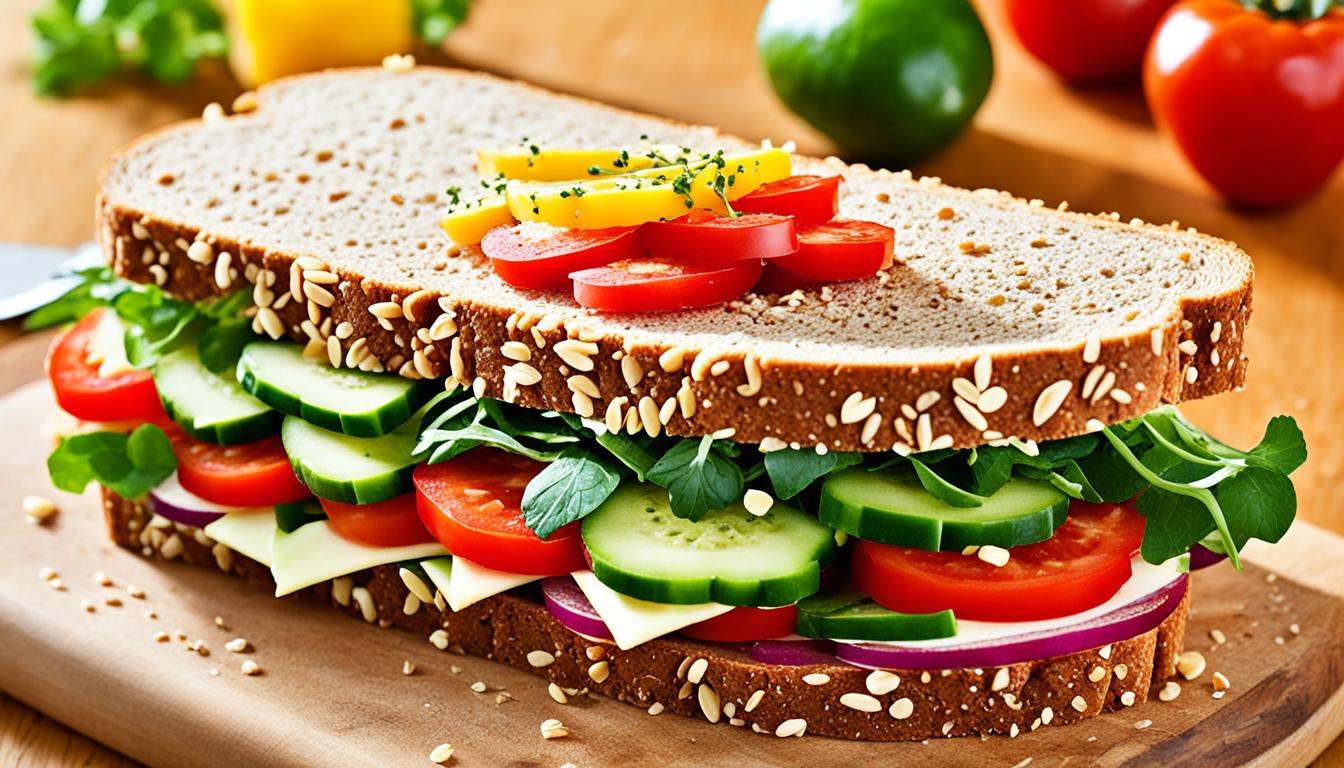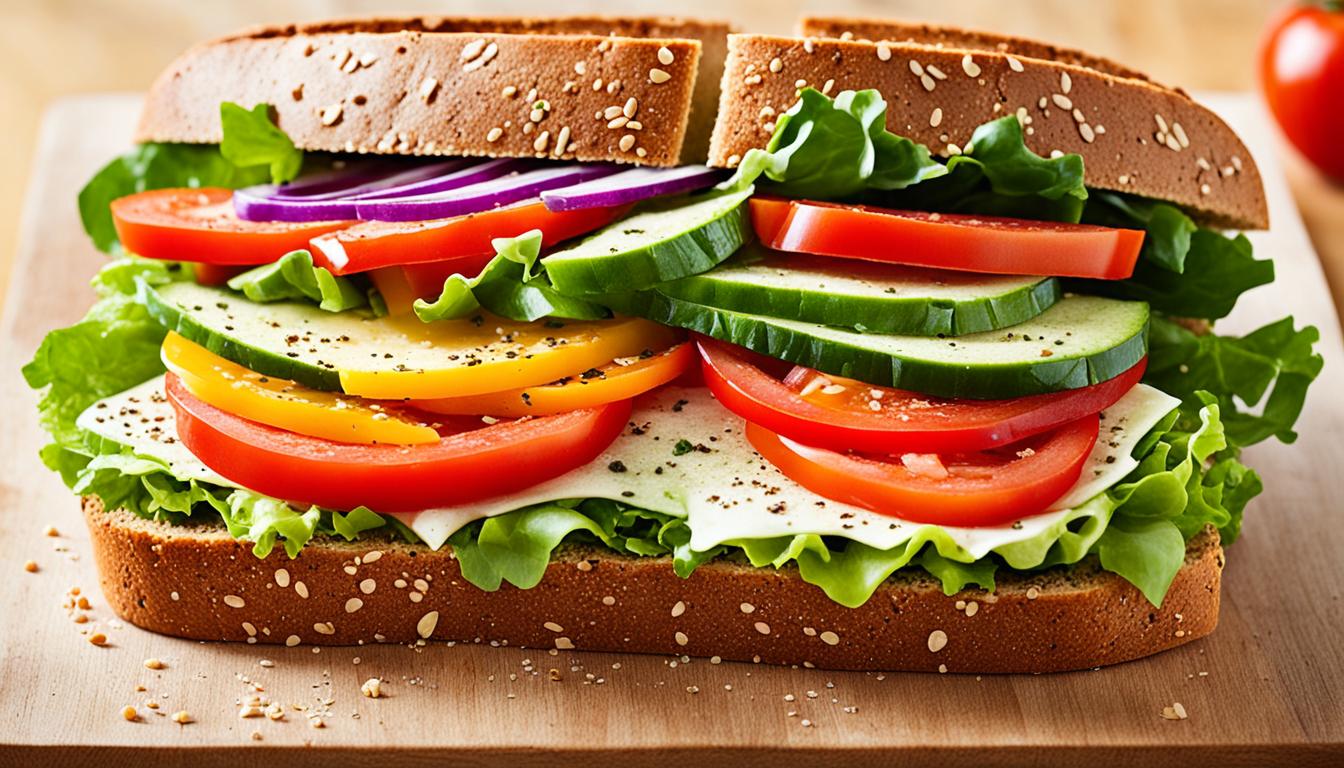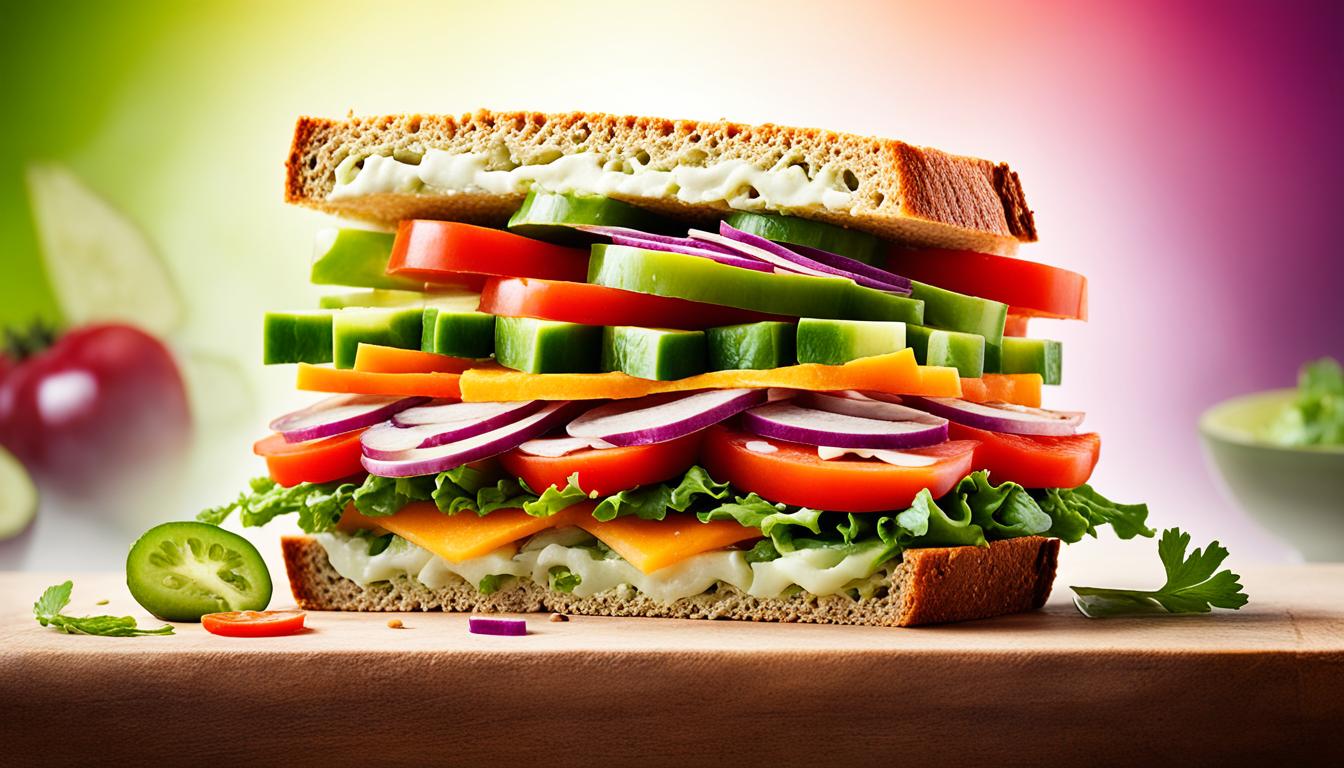Sandwiches are a convenient lunch option that can be enjoyed in any setting. However, many sandwiches lack nutritional value when made with processed meats, cheese, and refined white bread. To build a healthier sandwich, follow these easy guidelines:
Key Takeaways:
- Choose whole-wheat bread or lettuce wraps for added fiber and nutrients.
- Load up on fruits and vegetables to boost the nutritional value of your sandwich.
- Opt for lean proteins like sliced chicken, fish, or turkey.
- Use lighter spreads such as low-fat mayo or mustard to reduce calories.
- Experiment with different ingredients to add variety and flavor to your in good health sandwich.
Load up on Fruits and Vegetables
When building a healthier sandwich, prioritize adding fruits and vegetables as the star ingredients. Choose a variety of vegetables such as cucumber, tomato, zucchini, water chestnuts, lettuce, onions, pickles, and fresh peppers. These vibrant and colorful additions not only enhance the visual appeal but also provide a plethora of essential nutrients. They can be crunchy, juicy, or tender, adding texture and freshness to your sandwich.
For those who prefer hot sandwiches, consider adding avocados, cooked peppers, mushrooms, grilled onions, or spinach to create a delightful and satisfying filling. These flavorful options not only elevate the taste but also boost the nutritional value of your sandwich. The combination of these wholesome sandwich fillings ensures that you get a balanced dose of vitamins, minerals, and fiber.
By adding a generous amount of fruits and vegetables to your sandwich, you can create a healthy and wholesome meal that you’ll love to indulge in. These natural ingredients provide a burst of flavor, making your sandwich more exciting and enjoyable.

Add a Tangy Twist with Exotic Flavors
To take your sandwich to the next level, don’t be afraid to experiment with exotic flavors. Consider incorporating pickled vegetables, like kimchi, sauerkraut, or pickled jalapenos, to add a tangy and spicy kick. These additions not only bring a unique taste but also provide probiotics that support a healthy gut.
If you’re craving a hint of sweetness, try adding fruits like grilled pineapple, sliced apple, or dried cranberries. These fruits add a burst of natural sweetness that perfectly balances the savory elements of your sandwich. Furthermore, fruits offer important vitamins and antioxidants that promote overall well-being.
Remember, healthy sandwich ideas are not limited to the mundane. Get creative and experiment with different flavor combinations to find what excites your taste buds the most. Building a healthy sandwich doesn’t mean compromising on taste—instead, it’s an opportunity to explore new flavors and nourish your body.
Revamp Your Salad into a Sandwich
If you’re a salad lover, why not transform your favorite salad into a wholesome sandwich? Take a leafy green base like lettuce or baby spinach and layer it with your preferred protein such as grilled chicken, smoked salmon, or tofu. Then, add colorful vegetables, like sliced bell peppers, crunchy carrots, and juicy tomatoes, to give it a refreshing crunch. Finally, drizzle with a light dressing or your favorite vinaigrette for added flavor.
This creative twist allows you to enjoy the flavors and textures of a salad in a more convenient handheld form. Whether you’re picnicking in the park or enjoying your lunch break at the office, this salad-inspired sandwich will provide you with a satisfying and nutrient-packed meal.
Choose Lighter Spreads and Lean Proteins
To make your sandwich healthier and lower in calories, it’s important to choose lighter spreads and lean proteins. By opting for these options, you can enjoy a low-calorie sandwich that is still packed with nutrition.

Instead of using high-calorie spreads like mayonnaise or heavy sauces, try lighter alternatives such as low-fat mayo, salad dressing, mustard, or hummus. These options not only add great flavor to your sandwich but also help reduce the overall calorie content.
If you’re looking to add some extra taste and creaminess, consider adding a few slices of avocado. Avocado is a nutritious and delicious addition that provides healthy fats and enhances the sandwich’s texture.
When it comes to protein, choose lean options like sliced chicken, fish, turkey, or canned tuna or salmon. These protein sources are low in fat and calories, making them perfect for a low-calorie sandwich. Plant-based eaters can enjoy natural and less processed spreads like peanut butter or almond butter.
With these choices, you can create a nutritious sandwich that satisfies your hunger while keeping the calorie count in check. So go ahead and experiment with different spreads and lean proteins to create a variety of low-calorie and delicious sandwich recipes.
Opt for Whole Wheat Bread
When it comes to creating a sandwich for a balanced diet, your choice of bread plays a crucial role. Opting for whole wheat bread or other higher-fiber options can make your sandwich more filling and nutritious. Whole grains have numerous health benefits that can contribute to your overall well-being.
Whole wheat bread contains the entire grain, including the bran, germ, and endosperm, which provides essential nutrients such as fiber, B vitamins, and minerals. The fiber in whole grains slows down the absorption of sugar, helping to stabilize blood sugar levels and provide lasting energy. It also aids in promoting healthy digestion and preventing constipation.
“Whole grains slow down sugar absorption, improve blood sugar levels, and help decrease inflammation and cholesterol.”
Additionally, whole wheat bread offers anti-inflammatory properties and can help reduce the risk of chronic diseases such as heart disease and certain types of cancer. It can also help lower cholesterol levels, which contributes to better heart health. By choosing whole wheat bread, you can enjoy the sandwich without compromising taste or nutrition.
If you’re looking to reduce your carbohydrate intake, consider using lettuce as a refreshing alternative to bread. Lettuce wraps can be a low calorie sandwich option that still provides the crunch and texture you love. Simply wrap your chosen fillings in large lettuce leaves for a lighter and carb-conscious sandwich.
Remember to avoid white bread, which lacks fiber and essential nutrients. Opt for whole wheat bread or explore other whole grain options like rye or multigrain for added variety and nutritional benefits.

Conclusion
By following these guidelines, you can create delicious and healthy sandwiches that contribute to a balanced diet. Load up on a variety of fresh fruits and vegetables to add vitamins, minerals, and fiber to your meal. These wholesome ingredients not only enhance the nutritional value of your sandwich but also provide a burst of flavor.
When it comes to spreads, opt for lighter options like low-fat mayo, mustard, or hummus. These alternatives will add taste without adding unnecessary calories. For protein, choose lean options such as sliced chicken, turkey, or fish. Plant-based eaters can enjoy natural peanut butter or almond butter, adding a satisfying and nutritious element to their sandwich.
To make your sandwich even more nutritious, consider using whole-wheat bread or lettuce wraps. Whole-grain choices are rich in fiber, which aids digestion and helps maintain steady blood sugar levels. If you prefer a low-carb option, lettuce wraps are a great choice. They provide a refreshing crunch while reducing the overall calorie content of your sandwich.
With these simple tips and tricks, you can enjoy the benefits of an in good health sandwich. They are not only delicious but also contribute to your overall well-being. So, get creative, experiment with different combinations, and savor the satisfaction of a flavorful and nutritious sandwich. Whether you’re on the go or enjoying lunch at home, these healthy sandwich ideas will keep you satisfied and energized throughout the day.
FAQ
Why should I prioritize adding fruits and vegetables to my sandwich?
Adding fruits and vegetables to your sandwich provides a balance of nutrients and makes it more flavorful and nutritious. They are packed with vitamins, minerals, and fiber, which are essential for good health.
What are some examples of vegetables I can add to my sandwich?
You can add a variety of vegetables to your sandwich, such as cucumber, tomato, zucchini, water chestnuts, lettuce, onions, pickles, and fresh peppers. For hot sandwiches, consider adding avocados, cooked peppers, mushrooms, grilled onions, and spinach.
What spreads should I choose for a healthier sandwich?
Opt for lighter spreads such as low-fat mayo, salad dressing, mustard, or hummus instead of high-calorie options. You can also add flavor with a few slices of avocado or a splash of olive oil vinaigrette.
What are some lean protein options for sandwiches?
When it comes to protein, choose lean options like sliced chicken, fish, turkey, or canned tuna or salmon. Plant-based eaters can enjoy peanut butter or almond butter, preferably natural and less processed.
Should I choose whole-wheat bread for my sandwich?
Yes, opting for whole-wheat bread or other higher-fiber options is recommended. Whole grains slow down sugar absorption, improve blood sugar levels, and help decrease inflammation and cholesterol. You can also consider using lettuce as a wrap to reduce carb intake. Avoid white bread, which lacks fiber and nutrients.
Source Links
- https://www.everydayhealth.com/healthy-recipes/healthy-sandwich-dos-and-donts.aspx
- https://www.goodhousekeeping.com/food-recipes/healthy/g4081/healthy-sandwiches/
- https://www.eatingwell.com/gallery/8026324/healthy-sandwich-recipes-to-pack-for-work/


